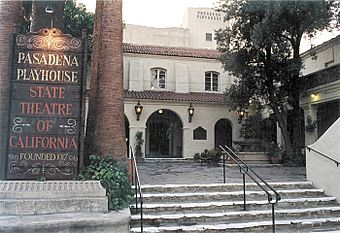Pasadena Playhouse facts for kids
 |
|
 |
|
| Address | 39 South El Molino Avenue Pasadena, California United States |
|---|---|
| Coordinates | 34°08′42.5″N 118°08′15″W / 34.145139°N 118.13750°W |
| Owner | Pasadena Playhouse State Theatre of California, Inc. |
| Type | Regional theatre |
| Capacity | 686 |
| Construction | |
| Opened | 1924 |
| Reopened | 1986 |
| Website | |
|
Pasadena Playhouse
|
|
| Architect | Elmer Grey A. Dwight Gibbs Cyril Bennett |
| Architectural style | Spanish Colonial Revival |
| NRHP reference No. | 75000435 |
| Added to NRHP | November 11, 1975 |
The Pasadena Playhouse is a famous place for performing arts in Pasadena, California, United States. It's located at 39 S. El Molino Avenue. This theatre has 686 seats and puts on many different shows each year. These include professional plays, artistic events, and community programs.
Contents
The Story of the Pasadena Playhouse
Around 1912, a new trend called the Little Theatre Movement started across the United States. This movement encouraged local communities to create their own theatres. The Pasadena Playhouse began in 1916. An actor and director named Gilmor Brown started putting on plays. He used a renovated theatre with his group, "The Gilmore Brown Players."
In 1917, Brown created the Community Playhouse Association of Pasadena. This group later became the Pasadena Playhouse Association. They needed a bigger and better place for their shows. The community theatre group grew very quickly. In May 1924, people in Pasadena raised money to build a new theatre. It was built in the city center at 39 South El Molino Avenue.
The new theatre was finished in 1925. It was designed in a Spanish Colonial Revival style. This style uses elements from old Spanish buildings. The architect was Elmer Grey, an artist from Pasadena. Another Pasadena artist, Alson S. Clark, painted the fire curtain inside.
The theatre started as a community project with lots of local support. Because of this, writer George Bernard Shaw called Pasadena "the Athens of the West." He compared the theatre to the ancient Greek Festival Dionysia. This shows how important the Playhouse was seen.
The building designed by Grey became famous across the country. It hosted world premieres of plays by well-known writers. These included Eugene O'Neill, William Saroyan, Noël Coward, F. Scott Fitzgerald, and Tennessee Williams. Many English language premieres of important European plays also happened here. In 1937, the California government officially recognized the Playhouse. It was named the State Theatre of California.
The Theatre School
In the late 1920s, a school for theatre arts was started at the Playhouse. By 1937, it became a full college. Many famous actors learned their skills here. Some of these include Raymond Burr, Victor Mature, Ernest Borgnine, Eleanor Parker, Charles Bronson, Gene Hackman, and Dustin Hoffman.
During the school years, the Playhouse was very busy. It often had five different stages running at the same time. The main stage alone had over 300 performances each year! Older homes nearby were turned into dorms for the many students.
The Playhouse could stage plays in many ways. This made it one of the first places in California to try new theatre styles. One example was theatre-in-the-round, where the audience sits all around the stage. The Playhouse also built and ran one of the first TV stations in Southern California. They even trained the Air Force to use TV and radio equipment. The Pasadena Playhouse provided many of the first trained TV technicians in the area.
In 1969, the School of Theatre Arts closed down. This happened because of changes in actor union rules and more drama departments opening in universities. Later that year, the theatre went bankrupt after its founder, Gilmor Brown, passed away.
The city bought the building in 1975. After being empty for 17 years, it was reopened in 1986. A real estate developer, David Houk, helped bring it back to life. The Playhouse started developing shows that would travel to other places in California. While the theatre reopened for community use, the acting school stayed closed. Over the next two decades, the theatre put on classic plays and new musicals. It also became an important educational place. Slowly, it became a major theatre again, earning over eight million dollars a year by 2008.
Famous People Who Studied or Performed Here
Many talented people have been part of the Pasadena Playhouse. Here are some of them:
- Ariana Grande
- Angela Bassett
- Wayne Brady
- Charles Bronson
- Raymond Burr
- Ruth Buzzi
- Jamie Farr
- Gene Hackman
- Dustin Hoffman
- Carolyn Jones
- Victor Jory
- Werner Klemperer
- Mako
- Victor Mature
- Rue McClanahan
- Joel McCrea
- Leonard Nimoy
- Nick Nolte
- Al Pacino
- Eleanor Parker
- Tyrone Power
- Robert Preston
- George Reeves
- Barbara Rush
- Sally Struthers
- Randolph Scott
- Harry Dean Stanton
- Gloria Stuart
- Robert Taylor
- Jo Anne Worley
- Gig Young
- Robert Young
Awards and Recognition
The Pasadena Playhouse has received many awards and nominations for its shows. Here are some of them:
| Awards | Production | Nominations | Wins | Notes |
|---|---|---|---|---|
| 2009 Ovation Awards | Stormy Weather | 3 | 0 | |
| 2011 Ovation Awards | Twist – An American Musical | 5 | 2 | Won for Scenic Design and Costume Design |
| 2012 Ovation Awards | The Heiress | 2 | 0 | |
| 2013 Ovation Awards | Fallen Angels (play) | 5 | 0 |
Financial Challenges and Recovery
Even with great reviews and popular shows, the Playhouse faced money problems after it reopened in the 1980s. It had a lot of debt from earlier costs to fix up the theatre. The people running the Playhouse found it hard to pay back loans and cover rising costs.
In January 2010, the Los Angeles Times announced that the theatre would close. This was due to financial difficulties. It closed on February 7 after its show Camelot. The rest of the 2010 season was canceled. On May 11, 2010, the Pasadena Playhouse filed for Chapter 11 bankruptcy. This meant they planned to reorganize their operations to reduce their debt.
Less than four months later, on July 7, 2010, the Playhouse was out of bankruptcy. An anonymous donor gave millions of dollars to help with operating costs. Also, some of their debts were canceled. The Playhouse also reduced its paid staff to only essential top managers. Artistic Director Sheldon Epps stayed on to help with the changes. Epps told the LA Times that these changes were to make the theatre financially strong again. This would help the Playhouse survive for the future. The Playhouse then announced a new schedule for Fall/Winter. It included a new show called Dangerous Beauty for January 2011. Plans for a new extension and a 400-seat venue, designed for free by Frank Gehry in 2007, were never built.
Many people who had bought season tickets chose to donate their refunds back to the theatre. This saved the theatre over a million dollars. Epps said that as the debt was lifted, these steps would help the theatre rebuild carefully and responsibly.
On April 1, 2011, the Playhouse held a "Premiere Gala: Opening Night." This event celebrated their new financial stability. They also announced the shows for the next year.
The Next Chapter
In 2017, Sheldon Epps left his role as artistic director after 20 years. During his time, Epps produced over 100 plays and directed 13 of them himself. Danny Feldman, who was the executive director at Labyrinth Theater Company in New York, was chosen to take his place.


